Physiotherapy & Rehabilitation
My Ortho Centre is governed under the guiding principles of providing affordable physiotherapy services to patients with Care, Compassion & Commitment.
My Ortho Centre in true sense is patient’s own physiotherapy facility as it provides physiotherapy tailored according to patient’s requirements. Team of friendly, highly skilled and experienced physiotherapists after thorough examining the patients individualizes physiotherapy protocol. Being a patient specific physiotherapy clinic, our patients get maximum benefit and response from the therapy.
Vision: Our concept is to establish “Therapeutic Center” of International standards emphasizing on the structural up gradation of facilities.
Mission:
• We intend to provide most modern clinic, with multiple treatment specialties, all under one roof.
• To create a platform for training all physiotherapy professionals by modern method of physiotherapy.
• To perform research on various diseases.
• To evolve effective treatment strategies for disease cure
Facilities
My Ortho Centre provides high score physiotherapy treatment with latest & advanced equipment’s.
SHORT WAVE DIATHERMY –
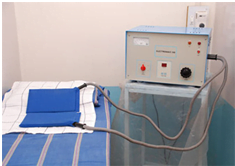
Short Wave Diathermy current is a high frequency alternating current. The heat energy obtained from the waves gives pain relief to the patient.
Where useful?
• Inflammatory conditions of shoulder and Elbow Joint (Tennis Elbow).
• Degenerative conditions of neck (Cervical Spondylosis).
• Osteoarthritis of Knee and hip joint.
• Ligament Sprains.
• Low Back Ache.
• Plantar fasciitis (Heel Pain), etc.
Where it should not be used?
• High Fever.
• Fluctuating Blood Pressure.
• Persons using Cardiac Pace Maker.
• Severe kidney and heart problems.
• Pregnant Women.
• Mentally Retarded Individuals.
Advantages:
• Relaxation of the muscles.
• Effective in bacterial infections.
• Relief of pain.
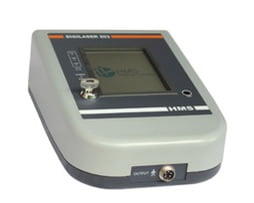
Laser Therapy is used for the treatment of various musculoskeletal conditions and injuries. This technology uses both red and infrared light to penetrate diseased or traumatize tissues. As these particles of energy (called photons) are absorbed into the skin and tissue, it results in a complex series of reactions that stimulate your cells to produce more energy, called ATP. This leads to decreasing pain, speeding up the inflammatory process, breaking down scar tissue, enhancing the immune system and encouraging the natural healing process. Laser is appropriate treatment for Soft tissue and Sport injuries, Whiplash injury, Back problems like Degenerative Disc Diseases, Disk Injuries, Osteoarthritis, Sciatica and Spinal Stenosis, Repetitive Strain Injuries like Tennis Elbow and Rotator Cuff Tendonitis, and inflammatory conditions like Plantar Fasciitis, Rheumatoid Arthritis and Bursitis. This treatment is non-toxic, non-invasive, and non-allergenic and there have been no adverse reactions reported. It is completely safe and even used in conditions where Short Wave Diathermy is contraindicated. The only contraindication of this therapy is its application on the womb in the first trimester and over a known malignancy.
TENS, IFT –
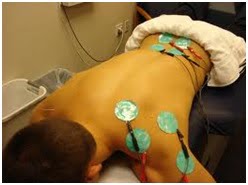
The word TENS stands for Transcutaneous Electrical Nerve Stimulation. The word IFT means Interferential Therapy. TENS and IFT are electrical modalities that deliver relatively low voltage electricity through small electrodes. The electrical stimulation gives a buzz feeling that distracts brain from the site of pain. Physiotherapists use these modalities to provide pain relief and often in conjunction with heat or ice therapy depending on the stage of injury.
NMES –
Neuromuscular electrical stimulation (NMES) is an electrical device that delivers electrical impulses to cause muscle contraction. It is useful in cases of improper functioning of muscles. Muscular dysfunction can occur following injury or surgery. NMES causes muscle to contract involuntarily thus assisting in strengthening weaker muscles and correcting muscle imbalances.
Ultrasound Therapy –
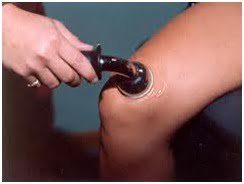
Ultrasound is a device that delivers sound waves to provide deep heat. This heat enhances blood flow in the area and stimulates healing. In early stage of injury Ultrasound Therapy decrease inflammation around a joint. In later stages, it is used to heat an area for mobilization or relaxation of muscles. As a result, it is very helpful in relieving pain.
Paraffin Wax Bath Unit
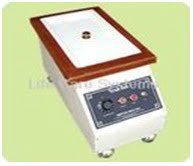
• Paraffin wax is used to relieve pain and stiffness of the joints.
• The temperature of wax is in the range between 40° to 44°C.
• It is useful in joint pain and stiffness, particularly in patients of osteoarthritis and rheumatoid arthritis. The duration for the therapy is about 30-45 minutes.
Cervical and Lumber Traction
Cervical traction is accepted as effective treatment for short term relief of neck pain. It can relieve muscle spasm and nerve root compression by stretching soft tissues and increasing the space between cervical vertebrae. Lumber traction can relieve pressure on compressed nerves. It helps muscles to relax and reduces muscle spasms. Lumbar traction increases the space between two vertebrae and thus helps in reducing pressure on intervertebral discs and nerve root.
Moist Heat Therapy Unit
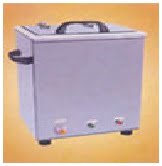
Moist heat therapy is used for ligament sprain, post fracture pain stiffness and painful conditions of joints.
Mobilization and Manipulation
Often joints in our body become stiff due to some injury, improper posture or as a part of arthritis. Stiffness in one joint can be a cause of pain in another joint. Physiotherapist assesses and treats stiffness by different techniques of mobilization and manipulation. Mobilizations consists of small passive movements, usually applied as a series of gentle stretches in a smooth, rhythmic fashion to the individual vertebrae or joint in the body. While in manipulation the joint is taken to end range and a thrust is applied to cause a crack or pop. These techniques are not only effective in increasing range of motion but also provide pain relief and joint nutrition. Most physiotherapy programs consist of mobilization and manipulation. Physiotherapist will always ask for your consent prior to these treatments. After every sitting of mobilization or manipulation our physiotherapist will teach you some exercises. This will maintain your new range of motion and will strengthen your weak muscles.
Exercises
Exercises are required to treat muscle imbalance which occurs when some muscles around the joint are weaker than others. Every good physiotherapy program consists of set of exercises that will strengthen weaker muscles and cause stretching of tight muscles. Physiotherapist advises exercises, some of which are done in clinic and others are as a part of home exercise program. Usually this consists of an exercise plan that will enable you to control your pain and strengthen your body part, so that the pain is less likely to recur. A unique difference between physiotherapist and practitioner is that physiotherapist will teach you how to become independent of your pain related medicines.
Type of Exercises Program –
- Work Conditioning Program – People may be off work due to a work related injury. Work conditioning programs are designed to rehabilitate individuals back to work. Physiotherapist can assess your injury and design injury specific rehabilitative program to help you to return to work. This often includes work stimulation exercises and other physiotherapy programs. Sometimes it is required to use a multi-disciplinary approach, where a team work of physiotherapist, occupational therapist, psychologist, family doctor and employer is required.
- Core Strengthening Exercise Program – In core strengthening exercises physiotherapist work on the abdominal and other postural muscles to help you to create and maintain ideal alignment. With increasing importance of core stability, most exercises programs emphasizes on core stability. By strengthening the core, stable foundation for the arms and legs are laid. These exercises are effective for the treatment of back pain and pain in other joints of the body.
- Balancing exercise – Balance is our fifth true senses and is controlled by vestibular system of human body. This system is located deep in the inner ear and consists of two components, the otoliths and the semi-circular canals. These components produce neural activity that is sent to the brain and gives us information with respect to up, down, side to side, and spinning movements. This system, like many of the systems in the human body can suffer from dysfunction and diseases. Typically this produces symptoms such as vertigo, disequilibrium, dizziness, and nausea. Vestibular rehabilitation is a unique education that Balance Physiotherapy offers.
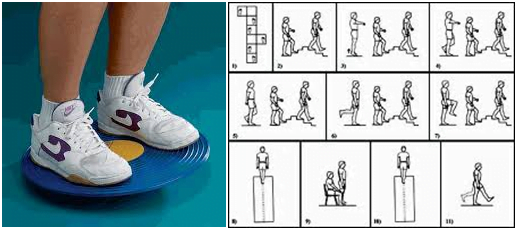
Taping
Taping is often used to support weaker joints and muscles. It is helpful in activating lazy or weak muscles and inhibiting overactive muscles. Taping also serves as a means of pain control by reminding us to straighten our posture. Taping can also be used to support a sprained joint for proper ligament healing.
Our Services
We provide Services in Neurological physiotherapy – Our Physiotherapists helps patients with neurological disorders to regain functionality.
We treat:
• Post Stroke Paralysis
• Balance disorder
• Spinal cord injury
• Rehabilitation after Brain and Spinal Cord Surgeries
• All nerve injuries.
Orthopedic Physiotherapy/ Musculoskeletal Physiotherapy – We have board certified qualified orthopedic physiotherapist having vast experience of treating all orthopedic and allied health related problems.
• Lower Back Pain
• Lumbar Canal Stenosis
• Cervical/ Lumbar Spondylosis
• Ankylosing Spondylitis
• Sciatica/ Degenerative disc disease
• Frozen Shoulder/ Periarthritis shoulder
• Post fracture Joint Stiffness.
• Post- Operative Joint Stiffness
• Osteoarthritis
• Mallet Finger/Trigger Finger/ Trigger Thumb
• Plantar Fasciitis
• Tennis elbow/ Golfer’s Elbow
• Polyarthritis / Rheumatoid Arthritis
Sports Physiotherapy – In Sports physiotherapy we specialized in physiotherapy for the sports person.
• Treatment of Sport Injuries like Muscle Spasm, Ligaments Strain, Muscle Sprain.
• Bio-mechanical analysis and correction of faulty techniques.
• Guidance for Warming up and Cooling down period
Physiotherapy in Rehabilitation – Rehabilitation is to bring back a disabled individual to his normal condition. Physiotherapy in Rehabilitation involves repeated training of physical abilities. Physiotherapy is required in the rehabilitation of patients of different debilitated conditions like Stroke, Cerebral palsy, Poliomyelitis, Spinal cord injury, Head Injuries and poly-trauma. Rehabilitation starts as soon as possible to speed recovery.
Physiotherapy in Obstetrics
Physiotherapy in obstetrics is concerned with musculoskeletal problems in pregnant female. It deals in postural care and physical fitness of women during pregnancy and after childbirth.
Postural Training during Pregnancy – Postural changes occur during pregnancy because of weight gain and laxity in ligamentous and connective tissue caused by hormonal changes. The postural changes of pregnancy are not often pathological, but unchecked postural changes may lead to acute or chronic low back pain syndrome. Evaluation and postural reeducation are necessary to prevent such squeals.
Treatment of musculoskeletal dysfunction – Physical therapists can combine patient education with therapeutic modalities to relieve discomfort related to pregnancy. Back pain, calf cramps, carpal tunnel syndrome, and varicosities are some pregnancy-related discomforts that may be treated by physical therapists.
Stress management through relaxation training during pregnancy – Discomforts such as insomnia, headaches, or muscular pain may occur during pregnancy. Stress in many cases is a causative or aggravating element. These symptoms are usually treated with medications, most of which are contraindicated in pregnancy. Thus physiotherapy has a great role in the management of these disorders. Relieving the symptoms of stress through the induction of relaxation is the treatment of choice. Relaxation-training techniques range from simple and concrete to more complex and abstract methods. The most commonly used methods for pregnant women are physiological relaxation, progressive relaxation and breathe awareness. Many relaxation methods teach the pregnant woman how to cope with the discomforts of parturition. Effective relaxation training can help pregnant female to control the relative discomforts of daily living.
Cardiothoracic Physiotherapy – In Cardiothoracic Physiotherapy we care about the physical fitness of most vital organs of our body, the heart and lungs. With physiotherapy we help in early recovery of patient from cardiopulmonary disorders. Physiotherapy massage and exercises helps in clearing away chest secretions. It helps in adequate oxygenation of body to the healing wound and the body.
Some of the conditions treated under this branch are – Asthma Increased chest secretions other respiratory infections and conditions Any General surgery like Appendicectomy Before and after Heart surgery Before and after the Lung surgery Intensive care unit care.
Physiotherapy in Fitness and Postural care – Here we are concern with guidance and care for physical fitness, good posture and muscle built.
Pediatric Physiotherapy – Pediatric Physiotherapy is the treatment for children who need to improve range of motion, strength, co-ordination, and postural control, quality of movement or gross motor development. Children with delayed motor development or neurological problems such as spina bifida, cerebral palsy or orthopedic conditions such as club feet, amputations, and torticollis require physiotherapy. Physiotherapy can be used for post fracture or post surgical rehabilitation and as a treatment for variety of chromosomal abnormalities like Down’s syndrome. Children may also need physiotherapy for a degenerative disease such as Muscular Dystrophy, or for one of many other medical syndromes.
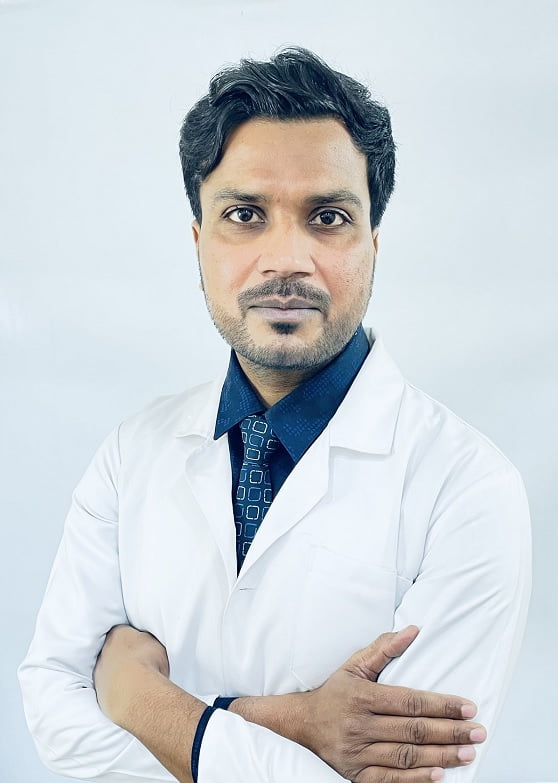
Dr. Ashvini Kumar Singh
Certification: Management in Sports Injury
Reg. No. – UPSMF434, DCPT: - PR2989
STT from TLM Naini Prayagraj Recognized by (WHO)
Dr. Ashvini Kumar Singh is an experienced Orthopaedic and Musculoskeletal Physiotherapist.
He worked for short term course in Leprosy Mission Hospital, Allahabad under World Health Organisation. During this period he had treated many post surgery patients of Reconstructive Surgery, Tendon Transplant Surgery, Amputations and Deformity Corrections.
For the last more than 15+ years he has been treating patients in Delhi/ NCR region with gratifying results and he worked in Metro Hospital (Noida), Aarogya Hospital(Vaishali, Sec-6), Sai Sanjeevni Hospital(Indrapuram), Navin Hospital(Vaishali, Sec-3) as a HOD. His patients from outside India include patients from UAE, Nigeria, and Africa. He is specialized in postoperative rehabilitation of patients of Joint Replacement Surgeries and Sports Injury.
Expertise in:-
- Taping Therapy – Kinesio, Rigid, Dynamic
- Cupping Therapy
- Dry needling therapy
- IASTM
- Fitness Training
- Manipulation and mobilization
- Management in Sports Injury


